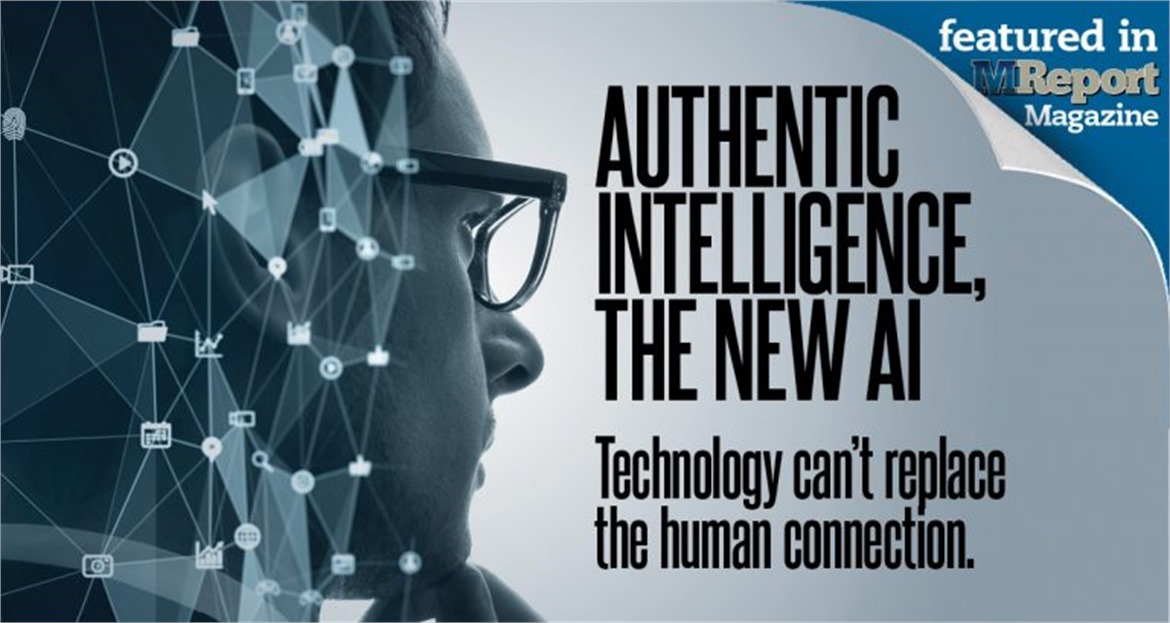
Usherpa Blog - Authentic Intelligence, the New AI
The technology loan officers have today is light years away from the tools I had when I was originating loans. In those days, a rolodex was a physical tool that sat on our desks. Today, we have Artificial Intelligence (AI), automated workflows, Big Data, and machine learning that all reside within the smartphones in our pockets.
We have the technology to do business from anywhere, but even with all of the advancements we’ve seen over the past 25 years, you still can’t originate a loan without a human in the process. Even the nation’s largest digital lenders shunt users from the cell phone app right into the call center to visit with a human being.
Today, we need technologies that don’t replace humans or the vitally important connections between them, but rather enhance them intelligently. That’s why I’ve quit referring to AI as artificial intelligence and started referring to it in a more industry appropriate manner as “Authentic Intelligence.”
Defining Authentic Intelligence
I’ve seen this shift from 1:1 personal interactions to AI-driven relationships during my 25-year career developing customer relationship management platforms for the real estate and mortgage lending sectors. While AI may make usable information more readily available, it seems to be solving for the wrong problems.
Namely, how to use that information to build relationships in a digital world. It’s lacking what our human brains inherently possess: Authentic intelligence. That is what’s going to make the difference in relationship-building in this era of human/machine coexistence. Here’s why.
More than half of businesses in North America use Big Data in one way or another. And using that data reportedly has led to notable profit increases. If you’re reading this, chances are you yourself have relied on some form of marketing automation, data scraping or social media-targeting technology over the past half-decade. Such data is all around us.
Sometimes, data can help businesses appeal to an increasingly tech-savvy consumer base. Surveys and market research show that a majority of individuals say they only interact with emails or marketing efforts that are personalized, and more than 50% of consumers willingly trade personal info and data to get personalized discounts.
That’s all well and good. But that same technology that effortlessly places “Hi, [FIRST NAME] [LAST NAME]” into an email greeting falls short on authenticity. What do I mean by that? Well, for all of its smarts, AI still doesn’t know how to ask about someone’s kid graduating high school or check in about how someone is feeling after changing jobs to care for an elderly parent, for example. It just can’t substitute for real, personal discussions or relationships. Where it can help, though, is in enhancing our own authentic intelligence to meet customers where they currently are.
Where AI Doesn’t Measure Up
Examples abound of AI’s failure to measure up and provide meaningful data. Some of these artificial intelligence failures are downright comical.
In a 2019 study, AI was confounded when tasked with identifying simple, unretouched images of mushrooms, squirrels, dragonflies, and bullfrogs. Not only did the AI fail 98% of the time, but some of the answers were borderline nonsensical. The squirrel, for example, was often confused with a sea lion.
Some examples aren’t so funny. AI technologies have been called out on numerous occasions for bias, misogyny, and critical failures when used in hiring processes, facial recognition, public safety measures, and more.
It’s simple for the majority of us to tell the difference between a squirrel and a sea lion. But such failures are all too common for AI, leading us back to a critical point: AI should be used to enhance, not substitute for human relationships.
Authentic Intelligence Explored: Customer-Centric Sales
Data can be used effectively for building relationships. And in today’s SaaS world, that means it should be a mutually beneficial tool for enhancing relationships between customers and sales team members.
Artificial intelligence is a recurring calendar notification of someone’s birthday from your CRM. Authentic intelligence is getting that notification but picking up the phone to wish someone happy birthday and asking if they’re going to be celebrating with a weekend getaway to the vacation property you helped them purchase two years ago.
Authentic Intelligence uses data combined with common sense and experience to build and maintain relationships. When people realize they are data points being manipulated by artificial intelligence, relationships break down and can be lost for good.
For especially long sales cycles or major, life-altering purchases, data-driven authentic intelligence can keep your business at the forefront for prospects, tailor approaches to communication, and keep your customers central to every activity.
In the mortgage and real estate industries, where my company, Usherpa, operates, sales cycles may be short or long, but engagements must always be long-term.
Often, the same people a real estate agent helped in their first home purchase a few years ago call up that same agent and ask for help on selling that home and buying their second. If the agent has really nurtured their relationship, those clients may have referred some friends and family along the way. This example of repeat business is exactly why it’s so important to maintain and enhance those hard-earned relationships with authentic intelligence.
Transactional relationships, like consumer goods sales or one-off purchases, can also benefit greatly from AI without feeling the pinch from a lack of relationship building.
When your business thrives on long-term engagement, it’s so important to treat those individuals as more than numbers, more than prospects. Where I see the major potential is in taking that same transactional data—the buying habits, the effectiveness of certain ads—and using it to craft specific, personalized, thoughtful outreach.
Human connection is where we thrive, and artificial intelligence can’t come close to replicating the ways we relate to one another.
This piece originally appeared in the February 2022 edition of MReport magazine, online now.


